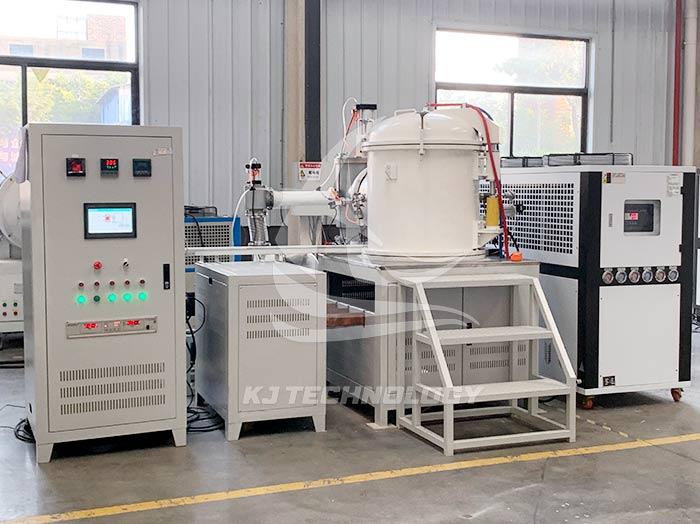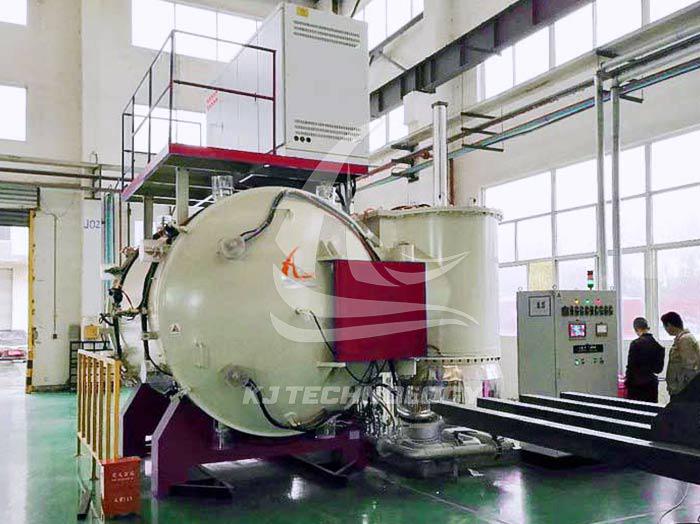The temperature of the vacuum degreasing furnace cannot rise
 08-22-2025 Author: KJ technology
08-22-2025 Author: KJ technology
The inability to increase the temperature of the vacuum degreasing furnace may be caused by various factors such as the heating system, vacuum environment, control system, equipment structure, or operation and maintenance. Specific causes need to be determined through systematic investigation and targeted solutions. The following is a detailed analysis and solution:
1. Heating system malfunction
Heating element damaged
Performance: Resistance wire breakage, graphite rod oxidation breakage, or heating tube leakage, resulting in local or overall heating failure.
Troubleshooting method:
Measure the resistance value of the heating element with a multimeter and compare it with the rated value. If the deviation exceeds ± 10%, it needs to be replaced.
Visually inspect the surface of the heating element for cracks, excessive oxide layer, or melting marks.
Solution: Replace the damaged heating element and ensure good contact during installation to avoid local overheating caused by looseness.
Power supply issue
Performance: Unstable voltage, insufficient current or circuit breaker tripping, resulting in insufficient heating power.
Troubleshooting method:
Measure the input voltage with a voltmeter to ensure it is within the rated range (e.g. 380V ± 5%).
Check whether the circuit breaker and contactor are aging or have poor contact, and replace them if necessary.
Solution: Contact an electrician to repair the power line or install a voltage regulator to stabilize the voltage.
Thermocouple malfunction
Performance: Thermocouple open circuit, short circuit or position deviation, resulting in temperature signal distortion and control system misjudgment.
Troubleshooting method:
Use a multimeter to measure the resistance value of a thermocouple, which should normally be several hundred ohms to several thousand ohms (depending on the model).
Check if the installation position of the thermocouple is close to the heating element to avoid direct radiation heat effects.
Solution: Replace the faulty thermocouple and recalibrate the temperature controller.
2. Impact of vacuum environment
Insufficient vacuum degree
Performance: Residual gases (such as oxygen and water vapor) in the furnace cause heat to dissipate through convection and conduction, reducing heating efficiency.
Troubleshooting method:
Measure the pressure inside the furnace using a vacuum gauge to ensure that it meets the process requirements (such as below 10 ⁻ ³ Pa).
Check whether the vacuum pump oil is contaminated and whether the pump body is leaking. If necessary, replace the pump oil or repair the pump.
Solution: Optimize the vacuuming process, such as pre vacuuming and then filling inert gas (such as nitrogen) before vacuuming to reduce residual gas.
Gas convection heat dissipation
Performance: Under low vacuum conditions, the density of gas molecules is high, causing heat to dissipate through convection.
Troubleshooting method:
Observe the gas flow inside the furnace, and if there is significant convection, increase the vacuum level.
Solution: Use high vacuum pumps such as molecular pumps or diffusion pumps to reduce gas molecule density and minimize convective heat dissipation.
3. Control system issues
Temperature controller malfunction
Performance: Improper PID parameter settings, abnormal output signals, or program errors result in the inability to adjust heating power according to the set curve.
Troubleshooting method:
Check if the displayed value of the temperature controller is consistent with the actual value. If there is a significant deviation, calibration is required.
Observe whether the heating power output adjusts with temperature changes. If the output remains constant, it may be a PID parameter issue.
Solution: Reset the PID parameters or contact the manufacturer to update the temperature controller program.
Program logic error
Performance: The heating program has been incorrectly modified or interrupted, resulting in the heating process being unable to proceed normally.
Troubleshooting method:
Check if the temperature controller program has been modified by misoperation or if there are any alarm messages.
Simulate the heating process and observe whether the temperature changes at each stage meet expectations.
Solution: Restore the default program or rewrite the heating curve, and strengthen operator training.
4. Defects in equipment structure and design
Poor insulation performance of furnace body
Performance: The high thermal conductivity of the furnace material, insufficient thickness of the insulation layer, or the presence of gaps result in a significant loss of heat.
Troubleshooting method:
Use an infrared thermal imager to detect the temperature distribution on the surface of the furnace. If there are localized high-temperature areas, it may be a problem with the insulation layer.
Check if the insulation layer is intact and if there is any damage or detachment.
Solution: Increase the thickness of the insulation layer or replace low thermal conductivity materials (such as ceramic fibers, aluminum silicate fibers), and repair the damaged areas.
Unreasonable layout of heating elements
Performance: Uneven distribution of heating elements or low power density leads to uneven temperature field inside the furnace.
Troubleshooting method:
Use temperature sensors to measure the temperature at different locations inside the furnace. If the deviation is too large, the layout needs to be optimized.
Check if the power of the heating element meets the process requirements.
Solution: Redesign the heating element layout, increase power density, or adopt zone control technology.
5. Improper operation and maintenance
Operator misoperation
Performance: Failure to operate according to regulations (such as heating without closing the furnace door or starting the vacuum pump), resulting in heat loss or equipment damage.
Troubleshooting method:
Check the operation records to confirm if there are any violations.
Observe the operation status of the equipment. If there is abnormal noise or alarm, it may be caused by misoperation.
Solution: Strengthen operator training, establish standardized operating procedures (SOP), and set up operation permission management.
Equipment has not been maintained for a long time
Performance: Carbon deposition on heating elements, contamination of vacuum pump oil, or aging of sensors leading to a decrease in equipment performance.
Troubleshooting method:
Regularly check the surface cleanliness of the heating element, and clean it if carbon deposits are present.
Replace the vacuum pump oil and clean the inside of the pump body.
Solution: Establish an equipment maintenance plan, regularly clean, calibrate, and replace vulnerable parts.








